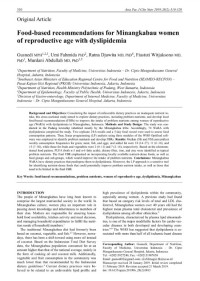Food-based recommendations for Minangkabau womenof reproductive age with dyslipidemia

Author
Gusnedi G - Personal NameUmi Fahmida - Personal Name
Ratna Djuwita, - Personal Name
Fiastuti Witjaksono - Personal Name
Murdani Abdullah - Personal Name
Background and Objectives: Considering the impact of unfavorable dietary practices on inadequate nutrient intake, this cross-sectional study aimed to explore dietary practices, including problem nutrients, and develop local food-based recommendations (FBRs) to improve the intake of problem nutrients among women of reproductive age (WoRA) with dyslipidemia in Minangkabau, Indonesia.
Methods and Study Design: The study was conducted in the Padang township inhabited mostly by the Minangkabau tribe. Accordingly, 74 WoRA with dyslipidemia completed the study. Two replicate 24 h recalls and a 5-day food record were used to assess food consumption patterns. Then, linear programming (LP) analysis using three modules of the WHO Optifood software was employed to identify problem nutrients and develop FBRs.
Results: Median (5th and 95th percentiles) weekly consumption frequencies for grain; meat, fish, and eggs; and added fat were 18 (14–27), 11 (6–16), and 15 (7–30), while those for fruits and vegetables were 2 (0–11) and 7 (2–16), respectively. Based on the aforementioned food pattern, PUFA (both n-3 and n-6 fatty acids), dietary fiber, iron, and zinc were identified as typical problem nutrients.
Conclusions: Minangkabau WoRA have dietary practices that predispose them to dyslipidemia. Moreover, the LP approach is a sensitive tool for identifying nutrient-dense foods that could potentially improve problem nutrient intake, as well as those that need to be limited in the final FBRThe final FBR emphasizedon incorporating locally available nutrient-dense foods, as well as food groups and sub-groups, which would improve the intake of problem nutrients. intake, as well as those that need to be limited in the final FBR.
Detail Information
| Series Title | : | - |
| Call Number | : | - |
| Publisher | : | : Asia Pac J Clin Nutr., 2019 |
| Collation | : | Asia Pac J Clin Nutr 2019;28(2):310-320 |
| Language | : | English |
| ISBN/ISSN | : | - |
| Classification | : | NONE |
 Computer Science, Information & General Works
Computer Science, Information & General Works  Philosophy & Psychology
Philosophy & Psychology  Religion
Religion  Social Sciences
Social Sciences  Language
Language  Pure Science
Pure Science  Applied Sciences
Applied Sciences  Art & Recreation
Art & Recreation  Literature
Literature  History & Geography
History & Geography